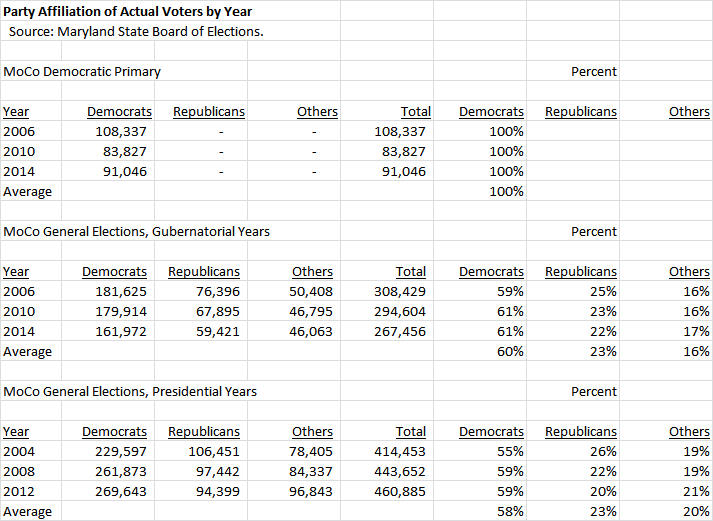By Adam Pagnucco.
In Part One, we began contrasting MoCo’s Two Electorates: namely, the Democratic primary voters who pick our elected officials, and the general election voters who decide charter amendments and ballot questions. Today we present new data on the two electorates from the voter file.
We have integrated the January 2015 voter file available from the county’s Board of Elections with a variety of U.S. Census demographic data to analyze two groups of MoCo voters. The first group, whom we call “Super Dems,” are those Democrats who voted in all three of the county’s 2006, 2010 and 2014 primaries. The second group, whom we call “Super Generals,” are those voters from all parties who voted in both the 2008 and 2012 presidential general elections. We would have also included 2004 voters if we could have, but the voter file doesn’t go back that far. Presidential general election voters are relevant to this year, which is also a presidential year in which term limits are on the ballot.
Let’s look at a few demographics for Super Dems and Super Generals.
Party Affiliation

Super Dems are, of course, 100% Democrats. Super Generals are 60% Democratic, 21% Republican and 18% others (most unaffiliated voters). This matches the distribution of general election votes referenced in Part One.
Gender

Both groups are majority female, with women being a slightly higher share of Super Dems.
Age

Super Dems skew towards seniors, with an average age of 64. Super Generals are much more diverse on this measure, with an average age of 55. While 19% of Super Generals are below age 40, only 3% of Super Dems are. And while 63% of Super Dems are age 60 or older, only 39% of Super Generals are. This means that while young voters are a meaningful voting bloc in general elections, they generally are not in MoCo Democratic primaries. The difference in average date of voter registration in the county further emphasizes the deeper roots Super Dems have in MoCo than Super Generals.
Average Household Income

This is not a significant differentiator between the two groups, although this data masks real differences in residence geography.
Residence Type

This is also not a significant differentiator. Both groups overwhelmingly live in single family homes and a big majority of them are probably home owners.
Location of Residence

Super Dems are more likely to live in Downcounty locations like Takoma Park, Chevy Chase, Bethesda, Kensington and Silver Spring while Super Generals are more spread out, including in Upcounty communities like Clarksburg, Damascus, Germantown and Montgomery Village. This has ideological implications. In this year’s Congressional District 8 primary, the very progressive Jamie Raskin ran up his biggest margins inside and near the Beltway, while the more moderate David Trone did best in northern areas.
District of Residence

Once again, the geographic split between the two groups is obvious. Fifty-four percent of Super Dems can be found in the two liberal strongholds of Council Districts 1 and 5, while Super Generals are more geographically balanced. This may help explain why three of four At-Large Council Members come from Takoma Park.
Precinct Demographics

Race and ethnicity are not available from voter registration data, but we can examine those factors for the precincts in which voters live. By this measure, Super Generals appear to be slightly more diverse than Super Dems. This suggests a need for more outreach to people of color by the Democratic Party, which should be their natural home.
We will conclude in Part Three.





